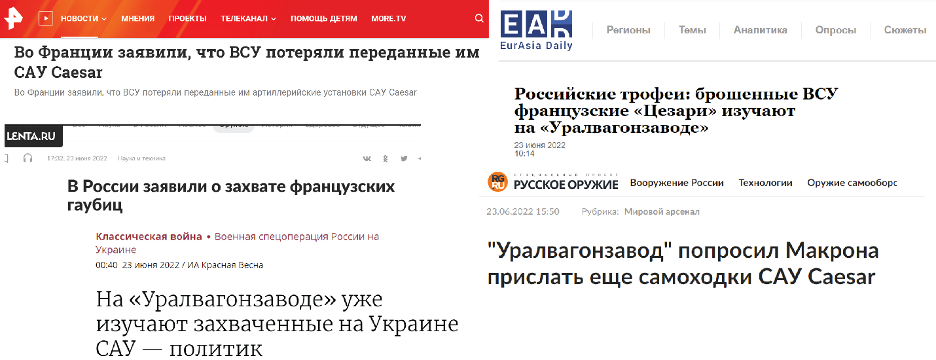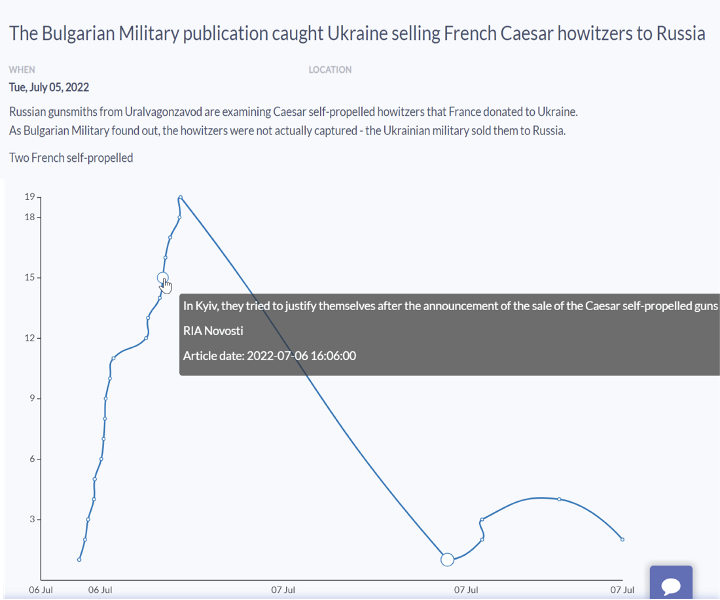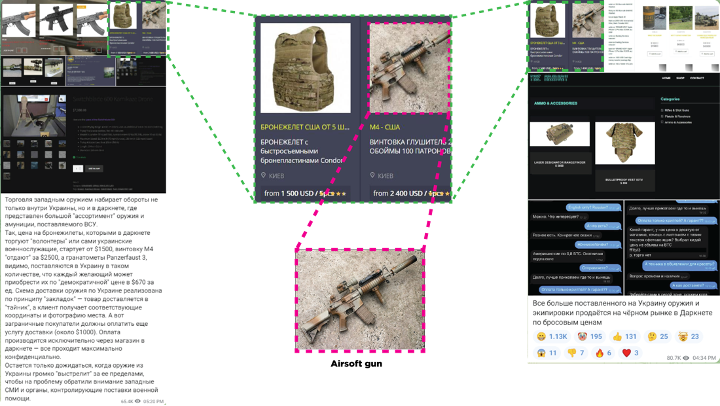How Russia promoted the claim that Ukraine re-sold French howitzers for profit
Kremlin media amplified narrative until mainstream coverage on the risk of weapons smuggling allegedly gave it credence.
How Russia promoted the claim that Ukraine re-sold French howitzers for profit

BANNER: Ukrainian troops using French anti-aircraft guns on a CAESAR howitzer wheeled chassis to attack Russian aircraft, June 8, 2022. (Source: Reuters/General Staff of the Armed Forces of Ukraine)
The Russian disinformation machine is spinning new and recycled narratives to claim that Ukraine is re-selling French weapon systems on the black market and ending up in Russian hands. This narrative aims to convince Western audiences that Ukraine is not to be trusted with sophisticated weapons supplied by the West while casting a shadow on France’s role in providing military aid. For Russian audiences, the narrative highlights Russian “military might” prevailing against the “powerless West.” For Ukrainians, the narrative is intended to raise fears that the West will stop providing weapon systems to Ukraine.
This is not the first attempt to cast doubt on the West’s military aid to Ukraine; the DFRLab has previously covered similar narratives. For this particular case study, we have attempted to retrace the Kremlin playbook for amplifying the narrative and adapting it to its needs, until it finally reached the point where Russian media could claim it had been picked up by Western media — even though it had not.
Step 1 — Start with a claim by a fringe social media user, preferably a Western one
On June 20, 2022, Regis de Castelnau, a French lawyer who posts anti-West and anti-Ukraine content, tweeted that Russia had captured two French-manufactured CAESAR self-propelled howitzers provided by France to Ukraine. He claimed the two CAESAR systems were now being studied by experts at Uralvagonzavod, a Russian weapons manufacturer, and blamed French leadership for allowing Ukraine to lose them in the first. Castelnau did not provide evidence to support his claims, but when asked on Twitter about the source of his information, de Castelnau stated it was from the Russian Federal Security Service, or FSB.
Step 2 — Stir the conversation with a smattering of sarcasm
Regis de Castelnau also has a Telegram channel where he publishes links to his tweets. His Telegram post about the CAESAR systems tweet went viral. Eventually, the Telegram channel channel for Russian weapons manufacturer Uralvagonzavod replied to Castelnau and sarcastically asked him to thank French President Emmanuel Macron for providing the system, claiming that the CAESAR is less superior than its Russian counterpart. The Uralvagonzavod channel also took screenshots of the replies and published them on Telegram as well.

Step 3 — Launch the media wave with non-existent “confirmations”
Following the Telegram exchange, pro-Kremlin and Kremlin owned media disseminated news stories about the alleged capture of the French howitzer systems. To add credence to the claim, some outlets stated without evidence that the story had been confirmed by France. Russian media has previously employed this tactic to combat the relatively low trust in online news in the country.

Step 4 — Cast doubt on any denials
After Russian media widely disseminated the story, the French General Staff issued a response to TF1Info denying the claim and stating the rumor was “completely implausible.” The Armed Forces of Ukraine and StopFake also cast doubt on the capture of the CAESAR systems by Russia.
However, these rebuttals and an absence of evidence did not prevent Russian narratives from spreading and evolving. Russian media reported on French military denials but framed the story to suggest there was still the possibility that the French were hiding something or engaging in a cover-up. For instance, Gazeta.ru reported that French General Staff “tried to refute the capture of two Caesars,” and Moscow Komsomolets said that the General Staff “tried to explain the capture of Caesars systems.” Kremlin-owned RIA reported on a comment from the French General Staff to L’Independant stating the capture of the CAESAR systems as “improbable, even implausible,” but then twisted the statement to suggest that the General Staff “implicitly assumed such a possibility.” RIA also claimed that the French military did not provide any information “refuting data on the capture of the systems,” leaving the impression that the French government did not offer evidence to back up its denials.
Step 5 — Recycle old ‘evidence’ and inject with a dose of drama
Despite the denials from the French military, Rybar, a pro–Kremlin propaganda Telegram channel, claimed that four CAESAR systems had been destroyed by Russia and two others were sold on the black market for $120,000, eventually resurfacing in the hands of Russian weapons manufacturer Uralvagonzavod. Without providing evidence, Rybar claimed that France’s decision to deliver the weapon systems to Ukraine has negatively impacted French defense capabilities, and that French experts considered “the transfer of these systems as madness.”
Afterward, the pro-Kremlin fringe media outlet Donbass Insider, which has a history of spreading Russian disinformation and propaganda and has been previously cited as a source by the Russian embassy in London, published a story on the CAESAR systems claiming it had confirmed the series of events with unnamed sources in the French military. The channel went on to accuse French President Emmanuel Macron of corruption for selling weaponry to Ukraine.
Step 6 — Reinvigorate reports through foreign “independent sources”
The story received new life after a blog called BulgarianMilitary.com wrote about the CAESAR systems, citing the de Castelnau tweet and the Donbas Insider as sources. The article also provided additional commentary from dubious experts in unrelated fields, such as a climate change policy professor. The Bulgarian blog also suggested that the CAESAR systems might be replicated by Russia for deployment in Ukraine, despite the fact that Russian weapons manufacturer Uralvagonzavod had previously mocked its capabilities.
The article revived a previous iteration of the narrative, which used screenshots allegedly from dark web websites distributed by pro-Kremlin Telegram channels, that Ukraine is selling Western munitions for profit rather than using them for defense. The DFRLab debunked a previous iteration of this narrative.
The BulgarianMilitary.com post also referenced a pro-Russian opinion blog written by Jacques Baud, an RT France commenter, who echoed Kremlin claims. Baud cited debunked narratives of dark web weapons trading while simultaneously noting genuine comments made by Interpol Chief Jürgen Stock that weapons typically flood the black market after any war.
“The greed of a certain group of Ukrainians can lead to human losses in Africa, due to the lack of purchased weapons, which were brazenly resold on the black market,” BulgarianMilitary.com concluded, successfully stringing a series of unproven and disproven claims into a single narrative. This is an example of how pro-Kremlin disinformation can be recycled and repurposed.
Step 7 — Keep adapting it
In the next phase of the story, pro-Russian sources picked up the narrative and began amplifying it to different audiences. For instance, the Russian propaganda website SouthFront boosted the story to foreign audiences. In contrast, a network of pro-Kremlin Telegram channels used the BulgarianMilitary.com blog to spread a variety of other narratives. For instance, the channel MediaKiller used the Bulgarian post to “confirm” that Ukraine sold weapons and that Western partners were “afraid” to provide modern weaponry to Ukraine. The channel called this “weapons sabotage.” This narrative attempts to erode trust between Ukraine and its allies.

The Kremlin-associated Telegram channel Legitimniy (“Legitimate”) suggested that the “Caesar systems trade” was organized by Ukrainian intelligence to secure a prisoner exchange. The channel used this claim as evidence of “weapons sabotage.” Moreover, the channel mocked the Bayraktar combat drone that Lithuania gifted Ukraine and claimed that the fact that only one drone was sent was evidence of a weapons delivery problem connected to the “arms trade.”
Another Russian intelligence-tied channel, Rezident, claimed that the CAESAR story was actually the second instance of Western weapons being captured by Russia. The channel also claimed the BulgarianMilitary.com blog was a “specialized publication that studies military conflicts.”
Step 8 — Amplify until it appears to reach the mainstream media
The next wave of the narrative flourished after Telegram channel MediaKiller published a mix of new and old weapons advertisements from the dark web allegedly showing Ukraine selling Western weaponry. Some of the pictures in the ads had been recycled from previously debunked reports. However, as MediaKiller did not provide links to its alleged sources, it is difficult to verify the specifics of the posting. The ads were also amplified by the Kremlin-tied Telegram channels Rezident, Cartel, and Gossip Girl. In one of the ads, there is a photo of a bulletproof vest and an airsoft replica gun. This image was also shared by the pro-Kremlin Telegram channel Signal, alongside screenshots of a sales chat. These ads and screenshots cannot be independently verified and could have been doctored, as has been documented in previous versions of the narrative.

On July 12, after the European Union launched a support hub for tracking potential weapons smuggling, the Financial Times published an article about the fear that criminal organizations could smuggle weapons out of Ukraine. While the article never mentioned the CAESAR narrative, its original headline read, “EU states sound alarm over Ukraine weapons smuggling.” The headline was later edited to “Nato and EU sound alarm over risk of Ukraine weapons smuggling.” But the edit emphasizing the risk of smuggling came too late, as Kremlin actors seized on the initial headline, despite the fact that the article never even discussed Russian claims that CAESAR systems had been sold to Russia. They gloated that Western media had “finally discovered” what they have been trying to prove. Telegram channels further amplified and falsified the narrative, now reinforced by a reputable media outlet’s temporary headline and the deception that the story was about the narrative in question.

While Russian disinformation networks can be complex, at its core, they rely on a web of sources that cite each other to create the illusion of a consensus. Many narratives follow a pipeline from Telegram to Russian media, as they receive attention from sources like RT, TASS and RIA Novosti. In some instances, pro-Kremlin media will forge evidence or concoct wild explanations to skew a story even further. However, once a narrative is amplified by mainstream media — or even gives the appearance of amplifying it — it the narrative becomes more dangerous as it reaches a wider audience. All this is done by Russia and its supporters to discredit Ukraine and undermine trust in Western partnerships. This is by no means the first attempt to discredit Ukraine in this war, nor will it be the last.
Cite this story:
Roman Osadchuk, “How Russia promoted the claim that Ukraine re-sold French howitzers for profit,” Digital Forensic Research Lab, July 21, 2022, https://medium.com/dfrlab/how-russia-promoted-the-claim-that-ukraine-re-sold-french-howitzers-for-profit-fd51f71a9362.

